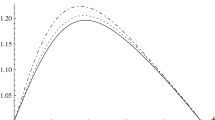Abstract
In an ultra-globalized industry, all existing firms service all markets (beyond partitioning and back to Krugman’s world). Moreover, intense competition may force firms with low productivity to compensate for losses at the home market with profits made on foreign markets. This raises the question: are there still gains from further trade liberalization in such a situation? We present a simple and tractable heterogeneous firms specification to address this question. The answer we find is this: yes, even more.
Similar content being viewed by others
Notes
See Cole and Davies (2010) for a related but different take on the effects of globalisation on the number of varieties available to customers.
Notice that Cole (2011) shows that iceberg and ad valorem barriers also differ in settings with heterogeneous firms.
The observable productivity of firms is heterogeneous, even though marginal productivity is homogeneous. See Schröder and Sørensen (2011) for a detailed discussion of theoretical and empirical measures of exporter productivity when firms are heterogeneous. In the present framework, firms spread an identical scale across different fixed costs. Thus observable productivity, such as value added over labor usage, is unique to each firm. Obviously, the true underlying driver of firm heterogeneity is ultimately an empirical question, and is likely to change for different industries, countries, and times.
Even though, we have identical marginal productivity (β), firms’ actual productivity (the inverse of average costs) is unique to each firm, depending on the different \( a_{i} \)’s. This can easily be verified by calculating firm total output over firm labor usage in the model.
Note that the distribution of active firms only runs from 0 to \( a_{{prod}} . \)
Note that the distribution of active firms only runs from 0 to \( a_{{ex}}^{b}. \)
See for example Jørgensen and Schröder (2008) for a similar approach.
Notice that even in an ultra-globalized scenario of zero-partitioning, where all firms serve both domestic and foreign markets, the number of domestic firms (m b) is greater than that in the case of partitioning (m p). Moreover, the number of varieties competing, including both domestic and foreign varieties, in the case of partitioning is the largest in both countries (v b > v p > v a). Therefore, the issue of possible endogenous markups due to firm’s market power (e.g., Melitz and Ottaviano 2008) will not arise.
References
Baldwin, R., & Forslid, R. (2010). Trade liberalization with heterogeneous firms. Review of Development Economics, 14(2), 161–176.
Bilkey, W. J. (1978). An attempted integration of the literature on the export behavior of firms. Journal of International Business Studies, 9(1), 33–46.
Cole, M. T. (2009). The choice of modeling firm heterogeneity and trade restrictions. (Working papers 200920). School of Economics, University College Dublin.
Cole, M. T. (2011). Not Not all trade restrictions are created equally. Review of World Economics/Weltwirtschaftliches Archiv, 147(3), 411–427.
Cole, M. T., & Davies, R. B. (2010). Royale with cheese: The effect of globalization on the variety of goods. (Working papers 201024). School of Economics, University College Dublin.
Demidova, S., & Rodriguez-Clare, A. (2009). Trade policy under firm-level heterogeneity in a small economy. Journal of International Economics, 78(1), 100–112.
Hopenhayn, H. (1992). Entry, exit, and firm dynamics in long run equilibrium. Econometrica, 60(5), 1127–1150.
Jørgensen, J. G., & Schröder, P. J. H. (2006). Tariffs and firm-level heterogeneous fixed export costs. Contributions to Economic Analysis & Policy, 5(1), 1–15.
Jørgensen, J. G., & Schröder, P. J. H. (2008). Fixed export cost heterogeneity, trade and welfare. European Economic Review, 52(7), 1256–1274.
Knight, G. A., & Cavusgil, S. T. (2004). Innovation, organizational capabilities, and the born-global firm. Journal of International Business Studies, 35(2), 124–141.
Krugman, P. (1979). Increasing returns, monopolistic competition, and international trade. Journal of International Economics, 9(4), 469–479.
Krugman, P. (1980). Scale economies, product differentiation, and the pattern of trade. American Economic Review, 70(5), 950–959.
Lawless, M. (2009). Firm export dynamics and the geography of trade. Journal of International Economics, 77(2), 245–254.
Lawless, M. (2010). Geography and firm exports: New evidence on the nature of sunk costs. Review of World Economics/Weltwirtschaftliches Archiv, 146(4), 691–708.
Lawless, M., & Whelan, K. (2008). Where do firms export, how much, and why? (Working papers 200821). School of Economics, University College Dublin.
Melitz, M. J. (2003). The impact of trade on intra-industry reallocations and aggregate industry productivity. Econometrica, 71(6), 1695–1725.
Melitz, M. J., & Ottaviano, G. (2008). Market size, trade, and productivity. Review of Economic Studies, 75(1), 295–316.
Moen, O., & Servais, P. (2002). Born global or gradual global? Examining the export behavior of small and medium-sized enterprises. Journal of International Marketing, 10(3), 49–72.
Montagna, C. (2001). Efficiency gaps, love of variety and international trade. Economica, 68(269), 27–44.
Roberts, M. J., & Tybout, J. R. (1997). The decision to export in colombia: An empirical model of entry with sunk costs. American Economic Review, 87(4), 545–564.
Schmitt, N., & Yu, Z., (2001). Economics of scale and the volume of intra-industry trade. Economics Letters, 74(1), 127–132.
Schröder, P. J. H., & Sørensen, A. (2012). Second thoughts on the exporter productivity premium. Canadian Journal of Economics, forthcoming.
Yu, Z. (2002). Entrepreneurship and intra-industry trade. Weltwirtschaftliches Archiv/Review of World Economics, 138(2), 277–290.
Acknowledgments
We wish to thank David Collie for helpful comments and clarifying discussions. Furthermore we benifited from the comments form participants at EARIE 2009. Jan G. Jørgensen gratefully acknowledges financial support from the Danish Social Sciences Research Council (grant no. 275-06-0025). Philipp J. H. Schröder gratefully acknowledges financial support from the Tuborgfoundation. Zhihao Yu gratefully acknowledges financial support from the Social Sciences and Humanities Research Council of Canada.
Author information
Authors and Affiliations
Corresponding author
About this article
Cite this article
Jørgensen, J.G., Schröder, P.J.H. & Yu, Z. Globalization beyond partitioning: back to Krugman’s world. Rev World Econ 148, 73–87 (2012). https://doi.org/10.1007/s10290-011-0111-0
Published:
Issue Date:
DOI: https://doi.org/10.1007/s10290-011-0111-0




